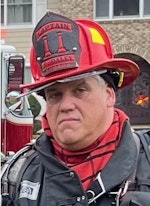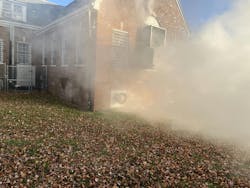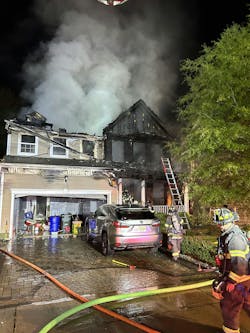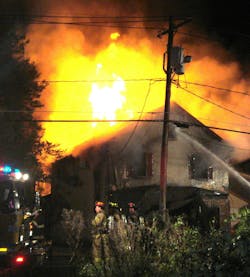Fire Studies: Volunteer Firefighting Strategies: Where We’ve Been. Where Are We Headed?
In 1998, the U.S. Congress recognized the need to address the national problem of work-related firefighter deaths and serious injuries. It began to fund the National Institute for Occupational Safety and Health’s (NIOSH) development and implementation of a firefighter safety initiative. The result was the NIOSH Fire Fighter Fatality Investigation and Prevention Program (FFFIPP). Since the program’s inception, the FFFIPP has investigated nearly 40 percent of firefighter LODDs across the United States. Investigations are divided into two categories: trauma and medical. From these reports, NIOSH identified the top five causal factors of firefighter deaths and injuries that occur on the fireground. These causes are referred to as the NIOSH 5.
NIOSH 5
The NIOSH 5 causal factors were identified as main contributors that continually surface in LODD and injury reports. They are:
Improper risk assessment. Getting as much accurate information on the fireground as possible is paramount to success. Not having all of the information leads to an incomplete assessment of what must be completed at the emergency. Information-gathering isn’t just completing the 360-degree size-up; it also includes thorough preplans regarding hazards in the first-due and second-due areas.
Lack of incident command. Every command class covers this: Someone must be in charge, and when the incident is expanding, so shall the incident management system that’s in place at the emergency. We need a clear command presence, with strong direction and responsibilities that won’t allow freelancing to occur.
Lack of accountability. On too many scenes, personnel accountability only becomes important when someone isn’t accounted for. Accountability must be a focal point immediately on arrival and remain in place until the last resource leaves the incident scene. Knowing where members are before the emergent event that happens on scene helps to keep everyone safer.
Inadequate communications. Know what channel you belong on when on scene, and if you don’t know, ask. Know who you must talk to when you have something to say. When you have something to say, be clear and concise. Think about what you want to say, push the button and say it. Then, clear the air to get confirmation that the message was received.
Lack of standard operating procedures (SOPs) or failure to follow established SOPs. SOPs serve as the blueprint for operations on the emergency scene. They are part of the playbook when it becomes “game time.” That isn’t to say that sometimes adjustments to the playbook aren’t necessary based on the circumstances on scene, but SOPs should serve as a starting point for on-scene operations.
For the better part of three decades, investigations of the incidents in the NIOSH reports continue to point toward these factors. If you read enough of the reports, you will find that multiples of these factors were present at the incidents. Not taking steps to mitigate these factors almost guarantees that these will continue to happen, as the following case studies suggest.
F2021-10: New York
On March 23, 2021, a 35-year-old volunteer firefighter was part of a response to a fire at an assisted-living facility. The firefighter was taking part in a massive rescue operation, removing residents from multiple floors of the facility. While the 35-year-old firefighter was working with other crew members on an upper floor, the crew’s low-air alarms began to sound. As their air supply was depleted, the crew attempted to exit the facility but were cut off. A mayday was called by the 35-year-old firefighter, but because of confusion on the fireground, a member who was removed was assumed to be the firefighter who initiated the mayday. Once it became apparent that another firefighter was missing, a rapid intervention team (RIT) was deployed, but it was unable to reach that member because of worsening conditions. Factors that were cited for this incident include lack of accountability; inadequate communications; inadequate command and control; and improper risk assessment.
F2020-11: Pennsylvania
On March 9, 2020, a 36-year-old volunteer firefighter was operating on scene of a structure fire. The firefighter was performing suppression activities in a defensive posture, because fire conditions in the structure inhibited an offensive attack. The firefighter was operating a hoseline from the front porch of the structure, which was heavy timber construction. The support columns for the porch were made of aluminum, which melted and split from the heat of the fire, which caused the porch to collapse onto the firefighter. The initial alarm assignment didn’t identify a RIT on scene at the time of the collapse, and multiple resources were called in to lift the porch off of the trapped firefighter. Factors that were cited for this incident include lack of an effective size-up; lack of accountability; lack of fireground training; and improper risk assessment.
F2019-16: Maine
On Sept. 16, 2019, a 68-year-old captain responded to a reported gas leak in an office building. The building was serviced by a large, exterior propane tank. Initial air sampling around the tank found no signs of a leak, but the tank was empty, and there were signs of frost on the lower sections of the tank as well as on the ground that was around the tank. A crew from another responding company was assigned air monitoring in the building and reported increasing lower explosive limit (LEL) readings as the crew descended into the basement. The reading was at 100 percent LEL at the bottom of the basement stairs. Less than a minute later, the building exploded. The captain was fatally injured in the blast. Factors that were cited for this incident include improper risk assessment; lack of incident management; and lack of training (metering and hazmat).
F2019-02: Maine
On March 1, 2019, a 32-year-old captain responded as a member of an engine company to a structure fire in a six-unit multifamily dwelling. With heavy smoke and fire showing on arrival, a second alarm was struck immediately. The captain and another crew member stretched a 1¾-inch handline into the structure to the third floor, because there was an occupant who reportedly was trapped in a third-floor apartment. While the line was stretched into the building, a police officer and another crew member raised a ladder to the third floor in the vicinity of the trapped occupant. The occupant was able to get to the ladder and climb out of the building. The police officer radioed the regional communications center (RCC) to report that the occupant was removed from the structure, but because organizations were operating on different channels, the message didn’t make it to command or the captain. The interior line was unable to make the third-floor apartment and a decision to back out was made. The crew couldn’t back down the stairs because of increasing fire conditions in the stairway, so the members looked for an alternative exit. The captain initiated a mayday transmission, which wasn’t acknowledged by either command or the RCC. A unit that arrived on the second alarm recognized that the interior crew hadn’t exited the structure and initiated another mayday transmission, bringing additional units and a RIT to the scene. The firefighter made it to the porch on the third floor and climbed down, but the captain wasn’t able to escape and was found by the RIT in the third-floor area. Factors that were cited for this incident include incomplete size-up and risk assessment; lack of incident management; lack of accountability; and inadequate communications.
Training and controls
There are methods that can be employed to eradicate the common causal factors that were present at the four aforementioned incidents. Through training, engineering controls and administrative controls, departments can make strides toward not repeating the negative actions of the past and move forward in providing a safer work environment in an already chaotic (at times) incident.
We have a duty to work toward removing the NIOSH 5 by recognizing these factors before they occur or by identifying them in after-action reports so that we can make certain that they don’t happen again. Education and training are key for identifying these points and incorporating proactive measures to prevent them from occurring on scene. We owe it to those who made the supreme sacrifice to learn from their incidents to identify and predict these factors and to execute alternative measures to make sure that everyone goes home after every response.
Product Spotlight
Firefighting Foam
SparkBarrier from Midwest Industrial Supply is a highly concentrated, Class A firefighting foam agent that’s approved by the U.S. Forest Service. It gives fire departments a tactical advantage in attacking, containing and extinguishing fires quickly and helps to reduce firefighters’ exposure to airborne toxins and hazardous conditions. Its thorough coverage prevents rekindling, to limit fire spread and the need for excessive water use. SparkBarrier works with standard water delivery systems and can be injected directly into the water stream with proper proportioning equipment.
sparkbarrier.com
Class A/B Foam Concentrate
Solberg Spartan 1-percent fluorine-free Class A/B foam concentrate from Perimeter Solutions was designed to give firefighters a tactical advantage to achieve total fire suppression on structure, wildland, vehicle, gasoline and dumpster fires. Engineered for rapid knockdown, it cuts water demand by 40 percent. It’s compatible with conventional firefighting equipment, such as inline eductors, self-inducting nozzles, low-expansion non-air-aspirating and air-aspirating nozzles, monitors, medium-expansion foam devices and compressed air foam systems.
perimeter-solutions.com
Attack Hose
Supreme II 1.75-inch is the next generation of Snap-tite Hose’s trusted, classic attack line. The double-jacketed fire hose delivers outstanding performance in both low- and high-pressure applications while offering exceptional value and durability. It features an Onyx nitrile rubber through-the-weave liner, to provide a smoother waterway for superior flow characteristics across all pressure ranges. A two-year all-hazard warranty complements a 10-year standard warranty and a lifetime delamination warranty.

Michael Daley
MICHAEL DALEY, who is a Firehouse contributing editor, recently retired as a 37-year veteran who served as a captain and department training officer in Monroe Township, NJ. He is a staff instructor at multiple New Jersey fire academies and is an adjunct professor in the Fire Science Program at Middlesex County College. Daley is a nationally known instructor who has presented at multiple conferences, including Firehouse Expo and Firehouse World. His education includes accreditations as a Chief Training Officer and a Fire Investigator, and he completed the Craftsman Level of education with Project Kill the Flashover. Daley is a member of the Institution of Fire Engineers and a FEMA Instructor and Rescue Officer with NJ Urban Search and Rescue Task Force 1. He operates Fire Service Performance Concepts, which is a training and research firm that delivers and develops training courses in many fire service competencies.









